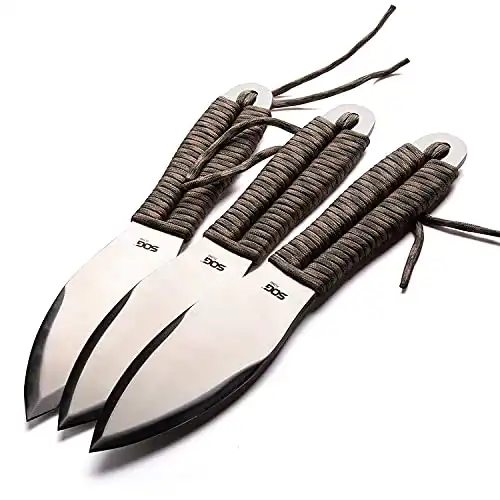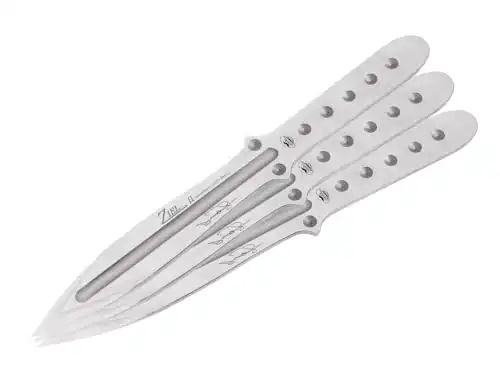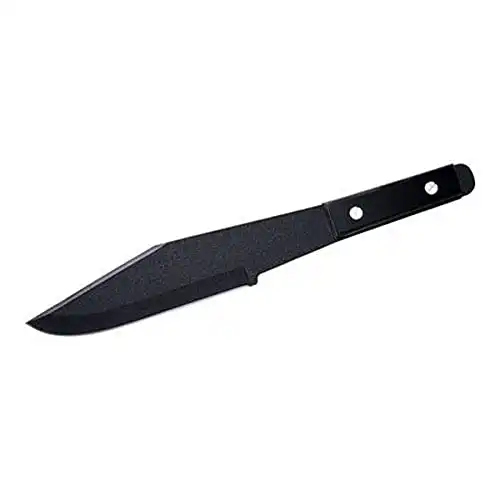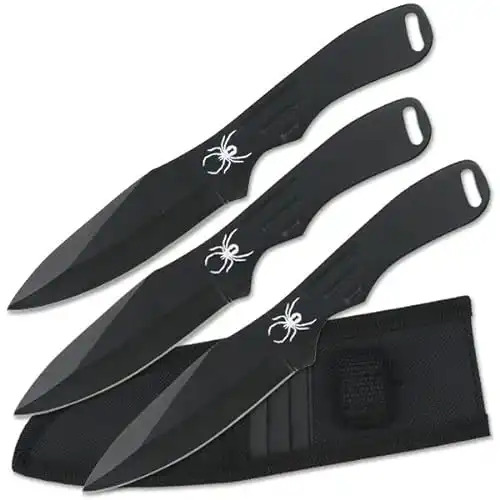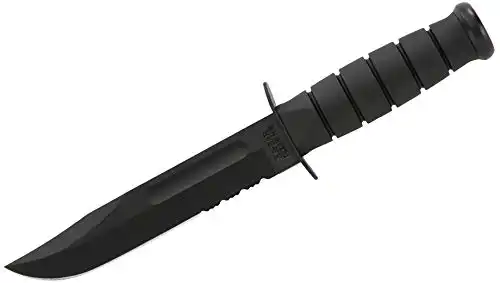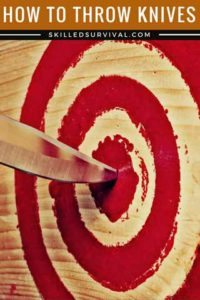
A Complete Guide To Throwing A Knife With Bullseye Accuracy
Because a skilled knife thrower is an incredible thing to behold.
But like most things in life…the experts “make it look easy.”
Throwing a knife with accuracy takes practice (and some guidance).
But that’s why YOUR hear, so lets get to it…
TOPICS IN THIS GUIDE… ↓(click to jump)
- Why You Should Learn This?
- Buy A Set Of Throwing Knives
- Throwing A Knife: Intro
- Different Throwing Motions
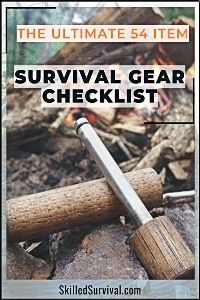
Want a free 54 item survival gear checklist?
Click here to instantly download this Complete Checklist PDF. No purchase necessary.Why You Should Learn This Skill?
First, why would you want to throw a knife in the first place?
Perhaps you want to know the skill as a “last resort” self-defense tactic.
Maybe you’d like to hunt small game silently and discreetly.
Or perhaps you dream of joining a circus to dazzle crowds with your bladed accuracy.
Or maybe you think throwing knives is badass.
Which it is indeed!
↓ The Best Knife Throwing Trick Shots
Learning the skill takes guidance regardless of why you want to throw a knife.
But before we dive in, I want to warn you – there’s some serious controversy surrounding the usefulness of this skill for self-defense and survival.
↓ Is Knife Throwing Useful?
Many believe if you enter a fight with a knife, you should NEVER throw away your weapon.
Not only are you effectively disarming yourself, but unless you make the perfect throw, you’ll make your assailant angrier (and now you have no weapon).
You also probably just armed your assailant with the weapon you threw at them…
It’s easy to see the logic there, and I agree.
But, like I said:
I’ve seen some amazing knife throwers in my day.
And it’s frightening to behold how accurately and powerfully some can sling a blade.
So it’s a matter of skill and experience.
Check out this video to see how effective and deadly it can be:
↓ Throwing Knives & Tomahawks vs. GEL/RIBS
Sure, you may be a beginner today.
But after a few years of practice, when some chump tries to mug you in a dark alley, you’ll have the confidence and ability to cast a knife and end his criminal days.
Don’t try until you can nail the target every time.
Buying A Set Of Throwing Knives
Now here is where things get tricky.
Because the internet is full of throwing knives for sale, I’m here to tell you that not all are created equal.
In fact, a lot out there are utter garbage.
This is an important section because the knife makes a difference. It needs to be weighted correctly and made of the right type of steel.
For a beginner, this step is easy to mess up – because you don’t know what you are looking for.
But do not worry; that is why this article is here.
This is a standard set of balanced throwing blades.
Their handles are wrapped in nylon cord for grip and weight, just like the old-school throwing knives bound with leather or sinew.
The cord offers a special survival bonus, as it can be removed in a survival emergency and repurposed.
Each SOG Fling knife is 9.5” and has a ballistic nylon sheath for storage.
↓ SOG Fling Throwing Knives Full Review
These knives are longer throwing knives, at 13.25”. The stainless steel blades look a bit like scalpels.
And at 14 ounces, they are heavy enough to surgically strike down anything they sink their hefty weight into.
The Magnum blades come with a very nice leather sheath for storage.
↓ Bailey Zeil Throwing Knives
Cold Steel is known for making excellent professional-grade throwing knives. And this intermediate Cold Steel Pro Balance Sport thrower is no exception to that.
The blade is expertly balanced and crafted with hard spring tempering. 13.25” long and 11.5 ounces, these professional throwing knives are an incredible bang for your buck.
You get nearly the same quality weapon that the pros use for a margin of the price.
↓ The Perfect Balance Thrower from Cold Steel
Another high-quality budget throwing knife is The Perfect Point RC-179 Series. It's a well-balanced knife and allows accurate throws every time.
It's made from black stainless steel construction and has a laser cut-out at the end of the handle that allows a lanyard to be tied to it.
It includes a black nylon sheath for safe transport, and each knife measures 8 inches in overall length.
↓ Review of Perfect Point Throwing Knives – Set of 3
First off, let me be clear - the KA-BAR is NOT designed specifically to be thrown.
However, if you're into survival (like we are), you may prefer to learn how to throw your survival knife (since we don't carry throwing knives in our bug-out bags).
↓ KA-BAR Knives Don’t Throw?
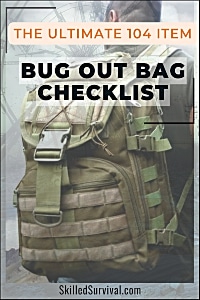
Want a free 104 item bug out bag checklist?
Click here to instantly download this Complete Checklist PDF. No purchase necessary.If you watched the video above, you noticed the Ka-Bar CAN be thrown with success with practice.
And when it hits its target, it’s a devastating blow.
Throwing A Knife Introduction
Sure, you could go into your kitchen, grab a bread knife and start hurling it around the house.
But you’re not going to have much success.
Instead, to practice correctly, get yourself a set of throwing knives and a safe space outside.
That way, you won’t throw toward anyone or anything valuable (i.e., the neighbor’s kids or cars).
In general, there are three types of throwing knives:
- Handle Heavy Knives
- Blade Heavy Knives
- Balanced Knives
How To Hold The Knife
You always want to hold the knife opposite the heavy end so the weighted side gets thrown first.
For example:
If you have a heavy handle knife, you will hold the blade – if you have a heavy blade knife, you will hold the handle.
Balanced blades can be thrown from either end and are the preferred knives amongst professionals.
Place your index, middle, and ring fingers on one side of the end you are holding and your thumb on the other.
Hold the knife gently but firmly.
↓ Time Warp: Knife-Throwing Physics
The Different Throwing Motions
There are many schools of thought on how to throw a knife.
There are many techniques, and none are right or wrong – they’re just different. And some work better than others.
For this article, I will explain a few of the most common ways:
↓ How To Throw A Knife | Axe | Tomahawk ↓
The Professional Technique
No matter how you throw the blade, the first step is always the same: find your “throwing line.”
This is the distance from you to your target – usually about five paces.
This is where most professionals throw from, and as a beginner, you’ll want to start here too.
Simply take a step forward from where you stand on the throwing line.
Keeping the knife horizontal to the target, swing, gently release, and always follow through (just like a good golf swing or baseball pitch).
While this method is perfect for practicing accuracy and getting a good feel for throwing a knife, it does not generate much Oomph.

Want a free 54 item survival gear checklist?
Click here to instantly download this Complete Checklist PDF. No purchase necessary.The Power Throw
You need extra steps to get more power out of your throw.
Once you have found your line, take another step backward and one more step at a 45-degree angle.
Stand with your weak shoulder to the target (left shoulder for the right-handed, right shoulder for the left-handed).
Place your back foot one step ahead of your front foot (almost like you’re mid-stride, with the target to your side).
Wind up, take a big step towards your line with your back foot (the one on your dominant side), and throw that knife friggin hard.
Once again: keep the knife horizontal to the target throughout the throw, gently let it go, and follow through.
With all your might, the extra step lets you pitch that knife like a baseball.
Successfully throwing a knife like this generates enough force to peg an animal you’re hunting or punch a hole in an enemy.
Timing the release is the hardest part of throwing.
Knowing when and how to let go of the blade so it spins correctly, flies the right way, and sinks where you want it to is a matter of trial and error.
Practicing is the only way to perfect this skill.
↓Throwing a Knife
The “No Spin” Throw
There is a third way to throw a knife.
It is not typical, but it can be effective.
The no-spin throw sounds exactly as it looks: the thrower launches its knife so that it doesn’t rotate to the target.
Start in the same place you would for the Power Throw (described above) and in almost the same stance.
But hold the knife with your pointer finger supporting the back edge of the knife.
Step outwards with your dominant leg and throw the knifepoint first towards the target, release gently, and follow through.
Watch the video for more details:
↓ No Spin Throwing Tutorial
BONUS! Shuriken and the Art of Shuriken Jutsu
Ninja stars, as they are commonly known, are another throwing knife.
I kept them separate from the other knives.
Why? Because they’re different from regular Western throwing knives (heavy-handled, heavy-bladed, or balanced).
↓ Ninja Stars For Self-Defense?!?! ↓
Shuriken were not typically instruments of assassination, as many people believe.
Most shuriken (most throwing knives, for that matter) cannot be thrown with enough force to stick directly into a person.
Especially if that person is very far away.
Instead, martial artists would use them to cut, slice, or nick their target’s skin.
They were used as distractions, and nuisances during fights, and used to target exposed areas of the body (like the eyes, and hands).
Ninjas were a crafty bunch – they would embed their shuriken into the ground so that enemies would step on them like caltrops.
They would wrap them in a lit fuse and throw them at structures to start fires.
They would wrap them in poisonous cloth, which they lit on fire before throwing, to cover a vast area in toxic smoke.
Heck, they were even used as handheld weapons, for close combat.
Shurikens didn’t have to be perfectly shaped “stars” either – many were made from nails or coins.
Shuriken came in many different shapes and sizes.
Some were circular with sharpened outer edges.
Others were more like pointed-throwing darts (known as Bo Shuriken).
They were perhaps the most effectively used throwing knives of all time.
Throwing a shuriken is very similar to throwing a regular knife.
You only need to make certain that you hold it so that the blade has no chance of cutting your skin when you release it.
The Japanese martial artists who developed the art of throwing shuriken (Shurikenjutsu) created more ways to throw these deadly weapons than you can imagine:
- overhead
- underarm
- sideways
- rear ways…
Sometimes in battle, they would whip out a shuriken so quickly and with such stealth, that warriors who got cut by them would think they were being attacked by an invisible swordsman.
↓ Learning to Throw Shuriken with no Experience ↓
The Final Word
Yes, a thrown knife can function as an additional self-defense weapon – if you know how to do it.
But it takes lots of practice.
If this is something that interests you, it’s a great hobby.
Much like darts or target shooting, throwing knives is a fun and relaxing way to practice a skill with some practical self-defense applications.
If you’re more into survival than knife-throwing competitions, you should learn how to throw your survival knife.
That way, you won’t weigh down your bug out bag with an unnecessary set of throwing knives.
Why Trust Skilled Survival...
Go here now to review a full breakdown of:
- Who We Are
- Our Credentials
- Our Mission
- & Product Recommendations...
Here are a few highlights of our teams credentials & certifications:
- Certified Member of a Mountain Search & Rescue Organization
- Plant Emergency & Safety Leader for a Major Food Manufacturer
- Member of the 10TH Mountain Division Hut Association
- Certifications: Avalanche 1, WFR, CPR
- Official Gear Tester for Numerous Outdoor Gear Companies
- Countless Multiday Backpacking trips into Remote Wilderness
- Bachelor's Degree In Mechanical Engineering
- Bachelor's Degree In Civil Engineering
- Bachelor's Degree In Biomedical Engineering
"It takes 20 years to build a reputation and five minutes to ruin it." - Warren Buffett
We're fully aware that trust is NOT something you GET but is EARNED.
And we'll continue to earn YOUR trust through our forthright and honest approach with each new Blog Post, Guide & Product we create...
Will Brendza

P.s. Do You Live In A 'Danger Zone' County?
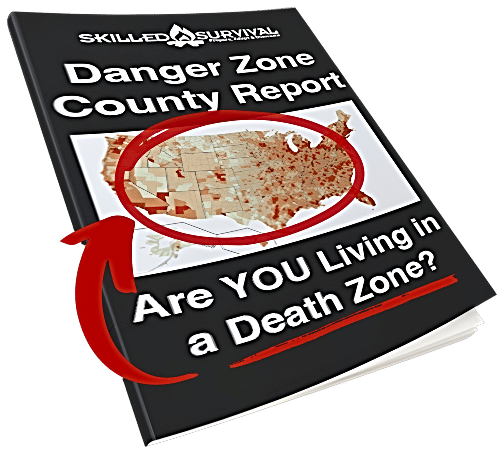
Find out now using my Danger Zone County List & Special Report it’s absolutely FREE.
In minutes you’ll know EXACTLY where you stand and if you should be worried or not..
So click here to get my FREE Danger Zone County List & Report…

Recommended Reading
Survival Pack: How To Build One NOW (before SHTF)
Survival pack list From Scratch. Packs That Will Make You A Hero To Your Family. Plus, Some Of Th Best Packs You Can Buy
Best Survival Packing List To Plan For An Evacuation
Everyone needs a survival packing list to organize their escape. That way you won't regret leaving something critical behind.
13 Best Wild Edibles ANYONE Can Find Nearly Everywhere…
Discover the best wild edible plants you can find and eat nearly anywere. Knowing and identifying these wild edibles could save your life.
How To Make Catfish Bait: My Grandpa’s Ultimate Recipe
I want to share with you what I consider the best catfish bait recipe. Here's how to make stink bait that will get the catfish to bite.
Paracord Projects: 17 Survival Devices You Can Make
I share the best paracord projects that are both fun and useful. By doing these crafts you'll always have lifesaving cordage on hand.
Best Survival Skills Every Adventurer Should Learn
The best survival skills will keep you alive even in extreme conditions. 1. Water 2. Shelters 3. Fire 4. Navigation 5. Signaling 6. Medical 7. Foraging...
